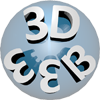
The aim of our work is to develop three-dimensional real space experience giving 3D websites. We have several options for the three-dimensional visualization that we have applied in our webpage.
First we used the well-known anaglyph (in our case red-cyan) technique. Our website is unique, because it can display spatial effects of text and images.
Another method that we apply is the side by side technique that requires special tools, but this method is the most effective for 3D immersion. The colour saturation is not reduced, the pictures are very realistic.
In the next step we used 3D representations that don’t require any special tool.
Autostereogram is the method with which certain three-dimensional images can be seen, using special watching technique. Atostereograms do not support long text or small details. Because of this drawback, just some part of the webpage can be displayed in stereograms.
The other 3D technique applied by us is the animated GIF that do not require any special tool, either. The three-dimensional animation effect can be seen with the naked eye, without any tricky watching. The images alternation caused by the depth of appearance.
Our further aim to develop special algorithms that can convert almost any two-dimensional webpage into three-dimensions.
Using the known rendering three dimensional methods, and the ones that we have improved or developed, we have created a 3D webpage (http://robotmodell3d.hu) that introduced the work of the students who won the TDK competition in the Dennis Gabor College in 2011, as well as, our own webpage (http://3dweb.hu) where additionally we demonstrate some further 3D techniques.
Another application of our results is the 3D version of the webpage of MTA SZTAKI, that will be available soon.
Participants
Dennis Gabor College
